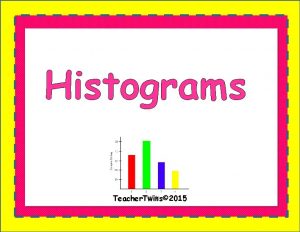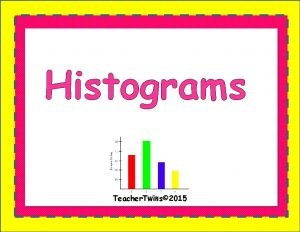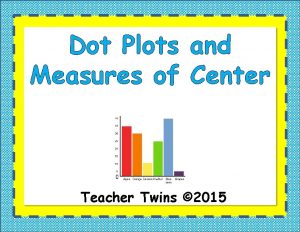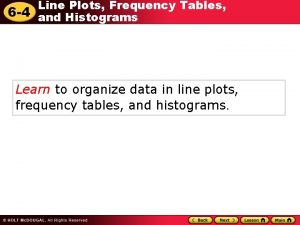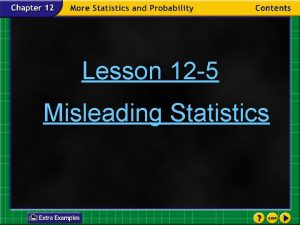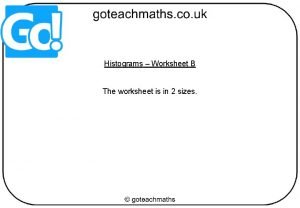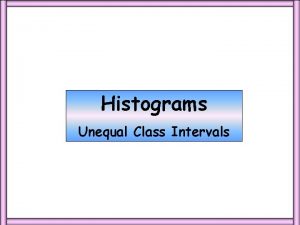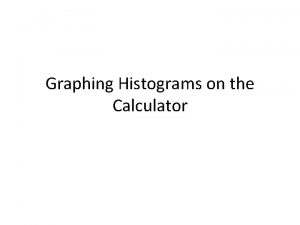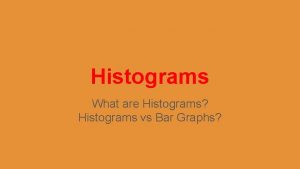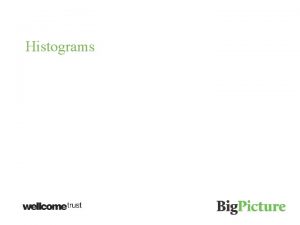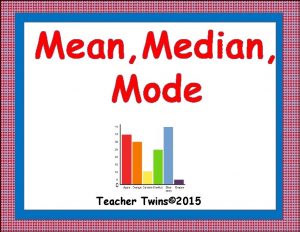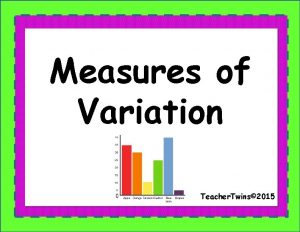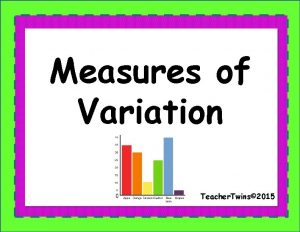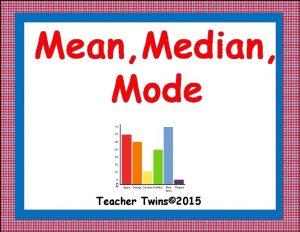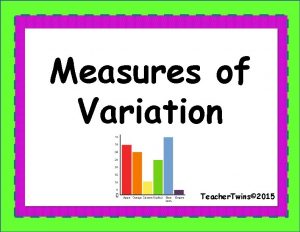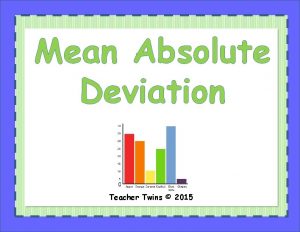Histograms Teacher Twins 2015 Warm Up Find the












- Slides: 12

Histograms Teacher. Twins© 2015

Warm Up Find the mean absolute deviation. Round to the nearest tenth. Explain what the MAD tells you about the spread of the data. 1). Number of rooms in your house 4, 5, 8, 10, 6, 7 The MAD is 1. 7 which means the average distance between each data value and the mean is 1. 7. 2). Hours spent per week exercising 10, 6, 2, 8, 9, 7 The MAD is 2 which means the average distance between each data value and the mean is 2.

Histograms Frequency A histogram is similar to a bar graph. Histograms show the frequency of data in intervals of the same size. 10 8 6 4 2 0 0 -2 3 -5 6 -8 9 -11 Number of Pets

Example 1: Create a histogram of the following data. Ages of people riding the Ro Roller Coaster. Age 11 -20 21 -30 31 -40 41 -50 51 -60 Frequency 20 16 12 7 2

Example 1: Create a histogram of the following data. When you look at the spread of the data you can see that it is skewed to the right. The mean is probably larger than the median. Ages of people riding the Ro Roller Coaster. Frequency 11 -20 20 21 -30 16 31 -40 12 41 -50 7 51 -60 2 Frequency Age 20 15 10 5 0 11 -20 21 -30 31 -40 41 -50 51 -60 Ages of People Riding Roller Coaster

Example 1: Find the median age of the people riding the Ro Roller Coaster. 57 people were surveyed. The median age is 21 -30. Ages of people riding the Ro Roller Coaster. Frequency 11 -20 20 21 -30 16 31 -40 12 41 -50 7 51 -60 2 Frequency Age 20 15 10 5 0 11 -20 21 -30 31 -40 41 -50 51 -60 Ages of People Riding Roller Coaster

Example 2: Create a histogram of the following data. Books Read Over the Summer. Books Read Frequency 2 -3 4 -5 6 -7 8 -9 10 -11 2 3 8 4 2

Example 2: Create a histogram of the following data. The data in the graph is symmetrical. The mean and median are close together. Books Read Over the Summer. Books Read Frequency 2 -3 4 -5 6 -7 8 -9 10 -11 2 3 8 4 2 8 Frequency 6 4 2 0 2 -3 4 -5 6 -7 8 -9 10 -11 Number of Books Read

Example 2: Find the median amount of books read during the summer. 19 people were surveyed. The median number of books read was 6 -7. Books Read Over the Summer. Books Read Frequency 2 -3 4 -5 6 -7 8 -9 10 -11 2 3 8 4 2 8 Frequency 6 4 2 0 2 -3 4 -5 6 -7 8 -9 10 -11 Number of Books Read

Practice 1). Create a histogram of the data. 2). Describe the spread of the data. 3). Find the median of the data. Hours Playing Video Games Frequency 0 -2 3 -5 6 -8 9 -11 2 2 5 8

Hours Playing 1). Practice Video Games 0 -2 3 -5 6 -8 9 -11 Frequency 8 Frequency 2 2 5 8 2). The data is skewed left. 3). The median number of hours is 6 -8 hours. 6 4 2 0 0 -2 3 -5 6 -8 9 -11 Hours Playing Video Games

Closure How is a histogram like a dot plot? How are they different?
 Teacher twins@2015
Teacher twins@2015 Teacher twins 2014 answer key
Teacher twins 2014 answer key Teacher twins@2015
Teacher twins@2015 Teacher twins 2015
Teacher twins 2015 What is the center of a dot plot
What is the center of a dot plot Teacher twins 2014
Teacher twins 2014 Teacher twins@2014
Teacher twins@2014 The teacher 2015
The teacher 2015 Frequency tables and line plots
Frequency tables and line plots Misleading histograms
Misleading histograms Histogram worksheet with answers
Histogram worksheet with answers A histogram of unequal class interval is the one
A histogram of unequal class interval is the one Histograms calculator
Histograms calculator


